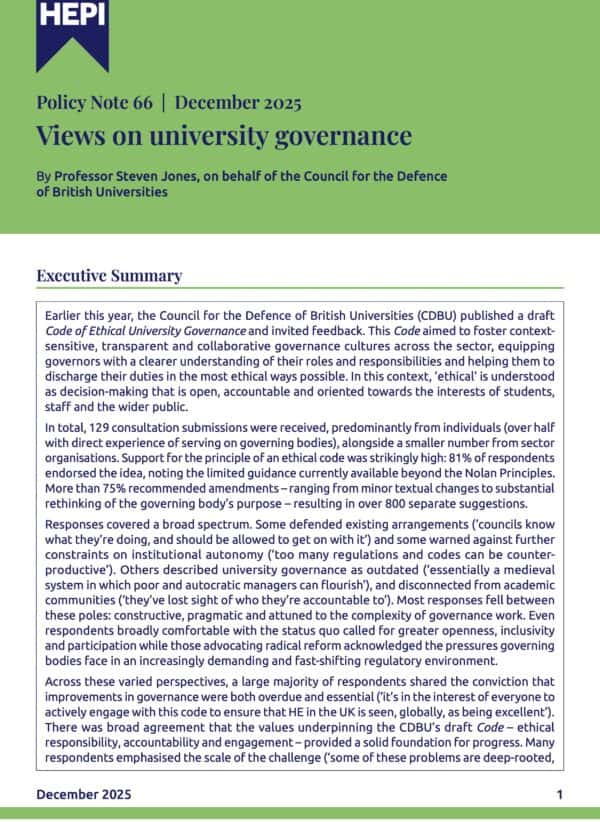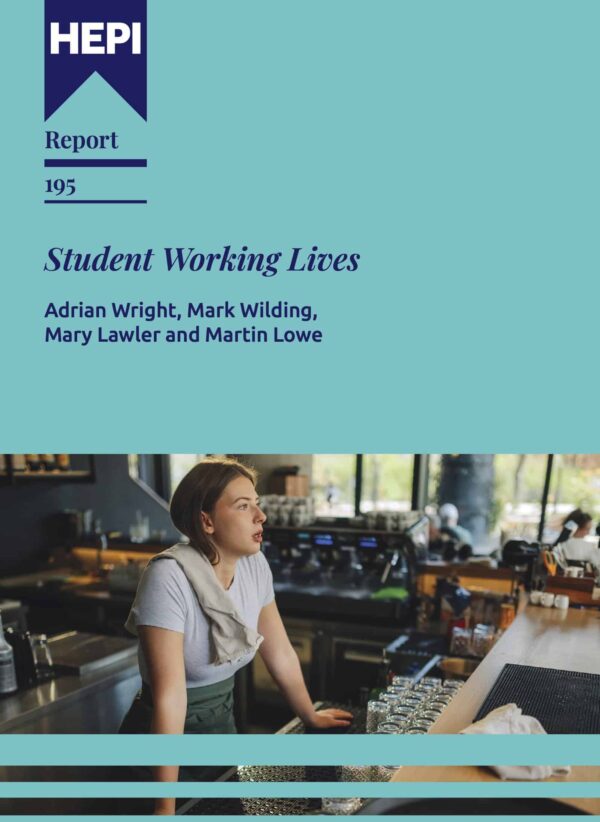Weekend Reading: From AI prohibition to integration – or why universities must pick up the pace
This HEPI guest blog was kindly authored by Mary Curnock Cook CBE, who chairs the Dyson Institute and is a Trustee at HEPI, and Bess Brennan, Chief of University Partnerships with Cadmus, which is running a series of collaborative events with UK university leaders about the challenges and opportunities of generative AI in higher education.
Are universities super tankers, drifting slowly through the ocean while students are speedboats, zipping around them? That was one of the most arresting images from the recent Kings x Cadmus Teaching and Learning Forum and captured a central theme running through the Forum: the mismatch between the pace of technological and social change facing universities and the slow speed of institutional adaptation when it comes to AI.
Yet the forum also highlighted a fundamental change in how higher education institutions are approaching AI in assessment – moving from a reactive, punitive stance to one of proactive partnership, a shift from AI prohibition to integration. As speaker after speaker acknowledged, the sector’s initial approach of trying to detect and prevent AI use has been shown to be both futile and counterproductive. As one speaker noted, ‘we cannot stop students using AI. We cannot detect it. So we have to redefine assessment.’

From left to right: Mary Curnock Cook, Professor Andrew Turner, Professor Parama Chaudhury, Professor Timothy Thompson. Source: Cadmus
This reality has forced some institutions to completely reconceptualise their relationship with AI technology in order to work with the tide rather than against it. Where AI was viewed as a threat to academic integrity, educators are beginning to see it as an inevitable part of the learning landscape that calls for thoughtful integration, not least so that students are equipped for change and the AI-driven workplace. For example, Coventry University has responded by moving its assessment entirely to a coursework-based approach, except where there are Professional, Statutory and Regulatory Body (PSRB) requirements, and explicitly allows the use of AI, in most cases, to assist.
Imperial College’s approach exemplifies this new thinking with its principle of using AI “to think with you and not for you.” This approach recognises AI as a thinking partner rather than a replacement for human cognition, fundamentally changing how universities structure learning experiences. The shift requires moving from output-focused assessment to process-based evaluation, where students must demonstrate their thinking journey alongside their final products.
Like many universities, Imperial is also concerned about equity of access to AI. As a baseline it offers enterprise access to a foundational LLM with firewalled data, Copilot, which ringfences the data within the institution. But it also has a multi-LLM portal pilot, which includes ChatGPT, Claude, Copilot, Gemini and DeepSeek, acting as an AI sandpit to help instil a culture of thinking of the LLMs as different tools to be experimented with – users can switch between them and ask them the same question to see the variation in results. Meanwhile, LSE has partnered with Anthropic to offer all students free access to Anthropic’s Claude for Education, which helps students by guiding their reasoning process, rather than simply providing answers.
Practical implementation challenges
This transition to integration requires practical frameworks that many institutions are still developing. A speaker voiced the sector’s uncertainty as: ‘We do not know the next development – we didn’t see this one coming.’ This unpredictability leads to what was termed ‘seeking safety in policy’ – a tendency to over-regulate when the real need is for adaptive frameworks.
The challenge of moving beyond traffic light systems (red/amber/green classifications for AI use) emerged repeatedly. These systems, while intuitive, often leave educators and students in the ambiguous amber zone without clear guidance: ‘everyone falls in the middle. You cannot do the red stuff but how do you enforce that? What do we really mean by the green stuff?’ Instead, some institutions are moving towards assessment-specific guidance that explicitly states when and how AI can be used for each task.
Cultural and systemic transformation
This technological shift demands profound cultural change within institutions. As one participant observed, ‘Culture change is being driven by students. Academics may not want to change but they no longer have a choice if they’re getting assessments written by AI – or they don’t know if the assessments are written by AI’. The pace of student adoption is outstripping institutional adaptation, creating tension between established academic practices and emerging student behaviours – those speedboats and super tankers again.
However, while the magnitude of the challenge calls for institutional-scale change and moving beyond individual innovations to systemic transformation, super tankers don’t turn quickly.
Strategic approaches to change at scale
Several institutions shared their successful strategies for managing large-scale change. The key appears to be starting with early adopters and building momentum through demonstrated success. As Cadmus founder Herk Kailis noted, change champions are: ‘the best people who are keeping the sector evolving and growing – and we need to get behind them as there aren’t that many of them.’ Imperial’s approach of appointing ‘AI futurists’ in each faculty demonstrates how institutions can systematically seed innovation while maintaining a connection to disciplinary expertise.
Another speaker observed that successful change requires ‘recognising the challenges and concerns of academic colleagues, bringing them together, supporting colleagues in making the changes they want.’ At Maynooth University, incentives for staff, such as fellowships and promotion pathway changes, rather than mandates, draws on the notion that ‘you can’t herd cats but you can move their food’.
Cross-institutional collaboration
The forum emphasised that institutional change cannot happen in isolation. The complexity of stakeholder groups – from faculty leads to central teams to students and student-facing services – requires sophisticated engagement strategies. As one participant noted about successful technology implementation: ‘Pilots don’t work if they are isolated with one stakeholder group. You need buy-in from all the groups.’
The call for sector-wide collaboration extends beyond individual institutions to include professional bodies, regulatory frameworks and quality assurance processes – QA must also keep up with the pace of change. PSRBs, in particular, were singled out as a blocker to change.
International networking is also important. For example, UCL is working with Digital Intelligence International Development Education Alliance (DI-IDEA) from Peking University, which is experimenting with AI in education in innovative and accelerated ways.
Building sustainable change
Perhaps most importantly, the forum recognised that sustainable institutional change requires long-term commitment and resource allocation, and this imperative could arguably not have come at a more difficult time for many HE institutions. The observation that ‘There’s never been a greater need and appetite from staff to engage with this at a time when resourcing in the sector is a real problem’ highlights the tension between ambition and capacity that many institutions face.
However, the success stories shared – such as Birmingham City University’s Cadmus implementation saving 735.2 hours of academic staff time while improving student outcomes – demonstrate that institutional change, while challenging, can deliver measurable benefits for both educators and learners when implemented thoughtfully and systematically.
Three recommended actions from the forum
1. Address systemic inequalities, not just assessment design
Research from the University of Manchester shared at the conference showed that 95% of differential attainment stems from factors beyond assessment itself – cultural awareness, digital poverty, caring responsibilities and lack of representation.
Action: Take a holistic approach to student success that addresses the whole student experience, implements universal design principles, and recognises that some students are ‘rolling loaded dice’ in the academic game of privilege. Don’t assume assessment reform alone will solve equity issues.
2. Reduce high-stakes assessment
Traditional exam-heavy models risk perpetuating inequalities and don’t reflect workplace realities. Multiple lower-stakes assessments can support deeper learning and may be more equitable.
Action: Systematically reduce reliance on high-stakes exams in favour of diverse and more authentic assessment methods. This helps to address both AI challenges and equity concerns while better preparing students for their futures.
3. Co-create with students as partners
Students are driving the pace of change – they are already using AI. They need to be partners in designing solutions, not just recipients of policies.
Action: Involve students in co-designing assessments, rubrics and AI policies. Create bi-directional dialogue about learning experiences and empower students to share learning strategies. Build trust through transparency and genuine partnership.







Comments
J Allan says:
Students have been coming to the conclusion over the past few years that HE degrees are not worth their time and money. Watch while society at large now concludes that a degree achieved with AI means precisely nothing.
Reply
Add comment